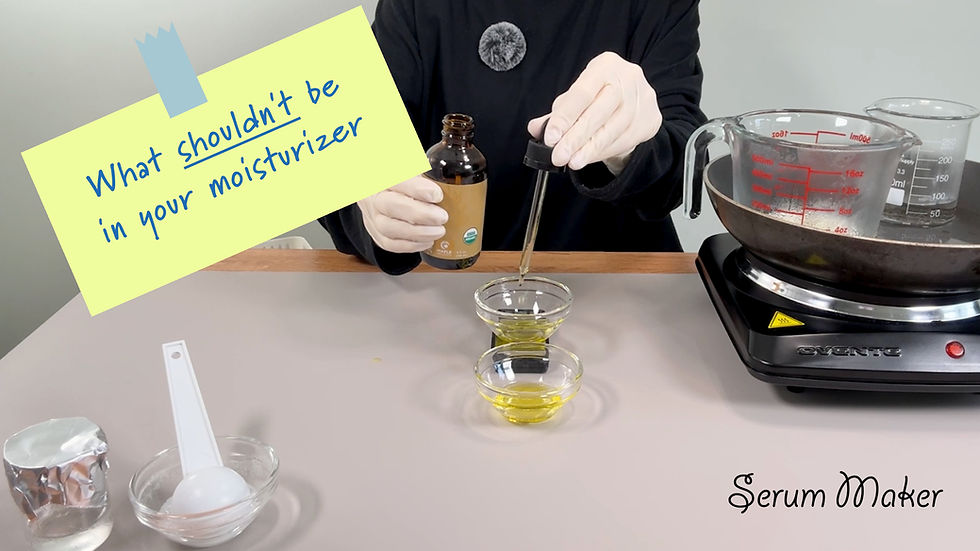Know What's in Your Moisturizer
- Serum Maker
- Jul 22
- 2 min read
Updated: Aug 27

Most of us have a favorite moisturizer - the one that feels rich, smells clean, and leaves a dewy finish. But here’s the question: is it actually doing anything for your skin? The truth is, many commercial moisturizers are masterclasses in marketing, not formulation. Behind the luxe packaging and glossy claims lies a long list of fluff: water-heavy bases, synthetic thickeners, silicones, and barrier-coating waxes that feel nice but don’t do much for your skin, and in some cases, can actually be harmful.
At Serum Maker, we use pure ingredients (you can get most on Amazon) and no fillers or chemicals. Here’s a list of ingredients you should be aware of:
Common Fillers in Skincare (a.k.a. The Fluff List)
1. Water (Aqua)
Not “bad” at all—it’s necessary for emulsions and hydration.
But in many formulas, it's up to 80% of the product. It's just hydrated filler unless paired with real actives.
2. Silicones
Names: Dimethicone, Cyclopentasiloxane, Cyclohexasiloxane, Trimethylsiloxysilicate
Makes products feel silky/smooth and gives a “blur” effect.
Doesn’t nourish—just coats the skin.
3. Mineral Oil / Paraffinum Liquidum / Petrolatum
Inexpensive occlusives used in place of rich, nourishing oils.
Creates a barrier but offers no skin nutrients.
Often used in drugstore “moisturizers.”
4. Polyethylene Glycols (PEGs)
Names: PEG-8, PEG-100 Stearate, etc.
Used as thickeners, softeners, solvents.
Do little for the skin—mainly formulation helpers.
5. Carbomers / Acrylates
Synthetic thickeners.
They’re what make gels and creams feel “bouncy” but do nothing for your skin.
6. Fragrance (Parfum)
Sounds fancy but often hides a cocktail of skin-sensitizing ingredients.
No skincare benefit—just adds scent and potential irritation.
7. Colorants & Dyes
Names: CI 42090 (Blue 1), CI 19140 (Yellow 5), etc.
Literally just there to make the product look pretty.
No benefit. Often unnecessary.
8. Alcohol (esp. SD Alcohol 40, Denatured Alcohol)
Dries quickly, gives a "tight" feeling.
Often added to make oily skin products feel matte, but can disrupt the barrier.
9. Microcrystalline Wax / Synthetic Waxes
Used to build structure or sheen in balms.
Cheap substitutes for natural waxes with fewer skin benefits.
If you're interested in knowing exactly what’s in your skincare products, and creating your own creams and serums without any mystery chemicals, take a quick Serum Maker course.
I recommend you start with the Serum Maker Essentials Course. You’ll get a lot of insider info on ingredients, their roles and how to include them in your own skincare routine. And I’ve included a huge bonus! The full course on the Serum Maker Vitamins, C, E and Ferulic serum. We go in deep examining the ingredients that the leading brand charges $182.00 for - and then we make a similar version together with a step-by-step video.
Plus, I’ll show you how much money you’ll save. Just wait til you see the math! You’ll never go back to retail.
Easy to understand recipes (not formulas)
Links to ingredients and tools you can purchase
Percentage conversion to grams calculator
pH Balance
Breakdown of Costs vs Retail
Learn more about ALL SERUM MAKER COURSES





Comments